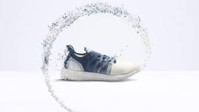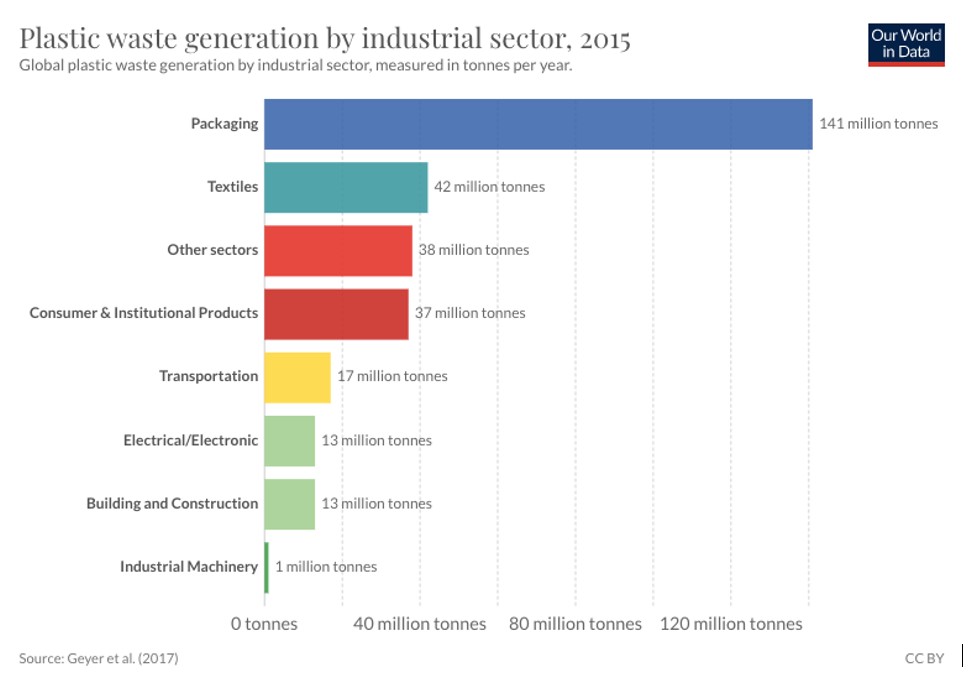I heard a story recently about a woman who had been practicing medicine in her native third-world country. She went to Thailand to do a surgical rotation. What struck her immediately was the staggering amount of plastic waste from disposable, single-use instruments. With the help of colleagues, she collected the instruments and sent them back to her home country for sterilization and reuse. From a health perspective, this may sound terrifying. But from an environmental standpoint, it makes perfect sense. Isn’t reusable, recyclable plastic all the rage?
As plastic tops the villain’s list for crimes against sustainability, I thought, as a packaging designer, I’d make an effort to separate rhetoric from reality. What’s new? What holds the most promise? And what’s the reality check?
Let’s start with the numbers
In December 2020, the World Economic Forum published recommendations on how to reduce plastic waste. This chart is a dramatic representation of packaging’s role in the waste problem:
The recommendations they offer for reducing packaging waste include eliminating plastic altogether, reusing bottles and moving away from single use to refills, newer, more recyclable materials, composting, and substituting bubblewrap with honeycomb paper materials. All good ideas, but are they being used en mass? Not yet.
However, promising new advances are emerging.
Is PLA the ‘Holy Grail?’
According to MTPak Coffee, it is. The brand uses PLA packaging for its biodegradable qualities:
- PLA is made from renewable sources such as maize, cornstarch, and sugarcane
- Producing PLA uses less energy: cutting greenhouse gases
- Packaging made with PLA can decompose in as little as 90 days compared to the 500 to 1000 years for traditional plastic
- PLA used in coffee packaging can protect the product up to 12 months (however, it’s also been noted that food protection with PLA lasts only about 4-6 months)
- PLA packaging accommodates different branding options
Sounds great, right? Okay, now let’s do a reality check
A reliable study had this to say, “Unfortunately, PLA isn’t the holy grail that will put an end to our reliance on plastic.” While PLAs produce fewer greenhouse gases, a study from the University of Pittsburgh revealed they generate more pollution due to pesticides and fertilizers. “Plus, who decides in the first place that crops should get utilized for creating bioplastic rather than feeding the 690 million undernourished people worldwide?”
PLA still has some significant hurdles that make wide-spread use unlikely. PLA requires a decomposting process that reaches 140 degrees Farenheit, according to Scientific American.
Putting PLA refuse in a recycling bin won’t get it to the right place. And most cities don’t have the facilities needed to compost this material, so it will just end up in a landfill and take centuries to decompose.
Final word on PLA can be found in this Google search:
“Does PLA biodegrade in landfill?
Only when sent to industrial composting facilities. It is essential that PLA plastics be heated to 140 degrees Fahrenheit and exposed to special digestive microbes so that they can biodegrade. As a result, the majority of PLA is discarded into landfills.”
Is PDK the answer?
According to Energy.gov, it’s a breakthrough. Here are just a few of the advantages of poly(diketoenamine) or PDK:
- Unlike traditional plastics which are recycled only 20-30% of the time, PDKs can be recycled without loss of performance.
- Fully recyclable plastic opens the door to reuse and is an alternative to incinerating or tossing in landfills where it takes centuries to decompose.
- PDK’s are manufactured in such a way that they can be melted down, not by heat but by acid, a more controllable process. “Without heat, the process is less carbon intensive than recycling typical plastic, and it allows more plastic to be reclaimed.”
Sounds great, but what’s the downside?
According to Fast Company, PDK plastic is not poised to replace all other plastics at this time. “To produce a virgin batch of PDK with current methods costs roughly 10 to 20 times more than regular plastics, largely because that process hasn’t been honed to scale with optimal efficiency yet. Also, its initial carbon footprint is actually worse due to a few specialized chemicals needed for the process.”
Right now, researchers are working with companies to test how PDK plastics can be optimized on a wider scale.
Brands putting their money where their mouth is
Meet the Adidas Loop
The Adidas Futurecraft Loop is made of 100% recycled material, shoes that come from ocean waste and shoes recycled from from earlier versions. Essentially, the Futurecraft Loop is a work in progress, not yet on the market. According to Fast Company, It started inside Adidas as an experiment. How do you recycle shoes over and over and not retain some of their past life, like grass stains, dirt and yellowing? Then there was the problem of shrinkage; a size 9 would shrink down to a size 6 as polymers tightened. Loop has gone through several generations, as Adidas addresses each challenge.
Plans to market and sell the Futurecraft Loop are still in the works, but the brand has one driving ambition: “how to get consumers to buy into the circular model before pretty much any other company in the world.” Adidas has been at it since 2016. Efforts like this are laudable.
The complexity of a closed-loop system
I often use the Harvard Business Review as my own reality check. Here’s a recap of their wisdom on our collective efforts to clean up the environment:
With the variety of products and materials in waste, scaling-up collection and recycling operations to deliver materials back for their original use and purpose can pose almost insurmountable complexity.
Recycling is not the fix to all the complexity. So, closed-loop approaches tend to be limited to commonly used and simple materials such as aluminum beverage cans, PET bottles, and lead-acid batteries. Some key obstacles to a true closed-loop system include:
- Consumers: There is a huge variety of waste materials. How much can consumers reasonably be expected to separate for collection, or at drop-off points?
- Collection: The number of different waste materials that can be collected separately. Collection locations are limited in space, and there are few safeguards against cross-contamination, plus waste needs to be bulked-up to deliver transport in the most efficient and cost-effective manner.
- Sorting: Separating waste for specific manufacturers or even specific technical applications during recycling can be impractical and unaffordable since the desired waste materials arise over wide geographic areas globally, and perhaps many years after they were produced.
- Transportation: For many industries, adopting the closed-loop approach to recycling as defined by the circular economy (CE) approach would involve returning materials to facilities as far away as China. This creates greater environmental impacts than recycling materials for lower grade applications, or even by using virgin materials.
5 things package designers can do to stay on top of sustainability
- Know the brand owner’s published commitment to sustainability to ensure that what you produce will not fall victim to greenwashing claims. Example: if you are using one of the newer plastics such as PLA or PDK, make sure to add labeling content that acknowledges biodegradability requirements — “not recommended for landfills.”
- Make sure your designers understand the “3 R’s: reduce, reuse, and recycle.”
- Have a packaging sustainability expert on staff who can work with clients to ensure that what you produce meets the environmental goals set by the brand owner. This person should be up to date on issues such as transportation from cradle to grave, and the costs associated with choice of materials and how to handle end-of-life disposal.
- Create a Lifecycle Assessment for the packaging you design and share with your client. This will demonstrate your knowledge and commitment to sustainability.
- Stay up with the latest insights. Reports from leaders such as Accenture will help you stay on top of consumer demand.



 Tom Newmaster
Tom Newmaster



















